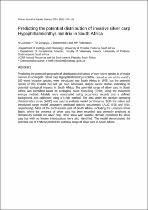 ResearchSpace
ResearchSpace
Predicting the potential distribution of invasive silver carp Hypophthalmichthys molitrix in South Africa
JavaScript is disabled for your browser. Some features of this site may not work without it.
- ResearchSpace
- →
- Research Publications/Outputs
- →
- Journal Articles
- →
- View Item
| dc.contributor.author |
Lübcker, N

|
|
| dc.contributor.author |
Zengeya, TA

|
|
| dc.contributor.author |
Dabrowski, James M

|
|
| dc.contributor.author |
Robertson, MP

|
|
| dc.date.accessioned | 2014-09-30T13:10:03Z | |
| dc.date.available | 2014-09-30T13:10:03Z | |
| dc.date.issued | 2014 | |
| dc.identifier.citation | Lübcker, N, Zengeya, T.A, Dabrowski, J and Robertson, M.P. 2014. Predicting the potential distribution of invasive silver carp Hypophthalmichthys molitrix in South Africa. African Journal of Aquatic Science, vol. 39(2), pp 157-165 | en_US |
| dc.identifier.issn | 1608-5914 | |
| dc.identifier.uri | http://www.tandfonline.com/doi/pdf/10.2989/16085914.2014.926856 | |
| dc.identifier.uri | http://hdl.handle.net/10204/7689 | |
| dc.description | Copyright: 2014 Taylor & Francis. This is an ABSTRACT ONLY. The definitive version is published in African Journal of Aquatic Science, vol. 39(2), pp 157-165 | en_US |
| dc.description.abstract | Predicting the potential geographical distribution and spread of non-native species is of major concern to ecologists. Silver carp Hypophthalmichthys molitrix, ranked as one of the world’s 100 worst invasive species, were introduced into South Africa in 1975, but the potential spread of this invader has not yet been addressed, despite recent studies indicating its potential ecological impacts in South Africa. The potential range of silver carp in South Africa was identified based on ecological niche modelling (ENM) using the maximum entropy method. Models were constructed using occurrence records and a defined background, and calibrated using a k-fold method. The area under the receiver operating characteristics curve (AUC) was used to evaluate model performance. Both the native and introduced range model accurately predicted species occurrences (AUC 0.98 and 0.94, respectively). Most of the north-eastern part of South Africa, including the Limpopo River Basin, where the presence of silver carp has been recorded, was correctly predicted as climatically suitable for silver carp. Other areas with suitable climatic conditions for silver carp but with no known introductions were also identified. The model demonstrated the potential use of ENM to predict the potential range of silver carp in South Africa. | en_US |
| dc.language.iso | en | en_US |
| dc.publisher | Taylor & Francis | en_US |
| dc.relation.ispartofseries | Workflow;13355 | |
| dc.subject | Asian carp | en_US |
| dc.subject | Correlative approaches | en_US |
| dc.subject | Cyprinidae | en_US |
| dc.subject | Ecological niche modelling | en_US |
| dc.subject | Maximum entropy | en_US |
| dc.title | Predicting the potential distribution of invasive silver carp Hypophthalmichthys molitrix in South Africa | en_US |
| dc.type | Article | en_US |
| dc.identifier.apacitation | Lübcker, N., Zengeya, T., Dabrowski, J. M., & Robertson, M. (2014). Predicting the potential distribution of invasive silver carp Hypophthalmichthys molitrix in South Africa. http://hdl.handle.net/10204/7689 | en_ZA |
| dc.identifier.chicagocitation | Lübcker, N, TA Zengeya, James M Dabrowski, and MP Robertson "Predicting the potential distribution of invasive silver carp Hypophthalmichthys molitrix in South Africa." (2014) http://hdl.handle.net/10204/7689 | en_ZA |
| dc.identifier.vancouvercitation | Lübcker N, Zengeya T, Dabrowski JM, Robertson M. Predicting the potential distribution of invasive silver carp Hypophthalmichthys molitrix in South Africa. 2014; http://hdl.handle.net/10204/7689. | en_ZA |
| dc.identifier.ris | TY - Article AU - Lübcker, N AU - Zengeya, TA AU - Dabrowski, James M AU - Robertson, MP AB - Predicting the potential geographical distribution and spread of non-native species is of major concern to ecologists. Silver carp Hypophthalmichthys molitrix, ranked as one of the world’s 100 worst invasive species, were introduced into South Africa in 1975, but the potential spread of this invader has not yet been addressed, despite recent studies indicating its potential ecological impacts in South Africa. The potential range of silver carp in South Africa was identified based on ecological niche modelling (ENM) using the maximum entropy method. Models were constructed using occurrence records and a defined background, and calibrated using a k-fold method. The area under the receiver operating characteristics curve (AUC) was used to evaluate model performance. Both the native and introduced range model accurately predicted species occurrences (AUC 0.98 and 0.94, respectively). Most of the north-eastern part of South Africa, including the Limpopo River Basin, where the presence of silver carp has been recorded, was correctly predicted as climatically suitable for silver carp. Other areas with suitable climatic conditions for silver carp but with no known introductions were also identified. The model demonstrated the potential use of ENM to predict the potential range of silver carp in South Africa. DA - 2014 DB - ResearchSpace DP - CSIR KW - Asian carp KW - Correlative approaches KW - Cyprinidae KW - Ecological niche modelling KW - Maximum entropy LK - https://researchspace.csir.co.za PY - 2014 SM - 1608-5914 T1 - Predicting the potential distribution of invasive silver carp Hypophthalmichthys molitrix in South Africa TI - Predicting the potential distribution of invasive silver carp Hypophthalmichthys molitrix in South Africa UR - http://hdl.handle.net/10204/7689 ER - | en_ZA |





